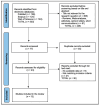Systematic Review of Lead Exposure and Its Effects on Caries and Aesthetics in Children and Adolescents
- PMID: 40565487
- PMCID: PMC12193460
- DOI: 10.3390/healthcare13121460
Systematic Review of Lead Exposure and Its Effects on Caries and Aesthetics in Children and Adolescents
Abstract
Background: Early childhood dental decay remains a pervasive chronic condition, and environmental toxicants-particularly lead-may exacerbate its development. This systematic review was designed to synthesize evidence on how lead exposure correlates with both the occurrence of carious lesions and aesthetic alterations in children's primary teeth. Methods: A comprehensive search was conducted in PubMed, Scopus, and Web of Science through April 2025, selecting observational investigations that assessed the link between lead levels and primary-tooth decay in pediatric cohorts. Thirteen eligible studies, encompassing 44,846 participants aged 2-19 years, were included for qualitative synthesis. Aesthetics were screened using author-defined enamel-defect or discoloration endpoints; however, only three studies reported compatible metrics, precluding quantitative pooling. Heterogeneity in exposure matrices likewise ruled out meta-analysis. Results: Most studies reported a statistically significant association between higher lead burden and greater prevalence or severity of caries in primary teeth. Blood lead concentrations across studies ranged from means of 1.53 μg/dL to geometric means of 7.2 μg/dL. Notably, elevated lead was linked to increased decayed, missing, or filled surfaces-with an adjusted risk ratio of 1.14 (95% CI: 1.02-1.27) at levels below 5 μg/dL-and adjusted mean ratios of up to 2.14 for decayed or filled teeth when blood lead reached 5-10 μg/dL. Conclusions: Current evidence suggests that children's exposure to lead may heighten the risk of caries and detract from the aesthetic quality of primary teeth. However, variability in study design, lead quantification methods, and confounder adjustment limit the consistency of findings. Mitigating lead exposure in early life could represent a valuable preventive strategy against dental decay in susceptible pediatric populations.
Keywords: aesthetics; children; deciduous teeth; dental caries; lead exposure; systematic review.
Conflict of interest statement
The authors declare no conflicts of interest.
Similar articles
-
Dental fillings for the treatment of caries in the primary dentition.Cochrane Database Syst Rev. 2009 Apr 15;(2):CD004483. doi: 10.1002/14651858.CD004483.pub2. Cochrane Database Syst Rev. 2009. Update in: Cochrane Database Syst Rev. 2016 Oct 17;10:CD004483. doi: 10.1002/14651858.CD004483.pub3. PMID: 19370602 Updated.
-
WITHDRAWN: Dental fillings for the treatment of caries in the primary dentition.Cochrane Database Syst Rev. 2016 Oct 17;10(10):CD004483. doi: 10.1002/14651858.CD004483.pub3. Cochrane Database Syst Rev. 2016. PMID: 27748505 Free PMC article.
-
Pit and fissure sealants for preventing dental decay in permanent teeth.Cochrane Database Syst Rev. 2017 Jul 31;7(7):CD001830. doi: 10.1002/14651858.CD001830.pub5. Cochrane Database Syst Rev. 2017. PMID: 28759120 Free PMC article.
-
Atraumatic restorative treatment versus conventional restorative treatment for managing dental caries.Cochrane Database Syst Rev. 2017 Dec 28;12(12):CD008072. doi: 10.1002/14651858.CD008072.pub2. Cochrane Database Syst Rev. 2017. PMID: 29284075 Free PMC article.
-
Sealants for preventing dental caries in primary teeth.Cochrane Database Syst Rev. 2022 Feb 11;2(2):CD012981. doi: 10.1002/14651858.CD012981.pub2. Cochrane Database Syst Rev. 2022. PMID: 35146744 Free PMC article.
References
Publication types
LinkOut - more resources
Full Text Sources
Miscellaneous


